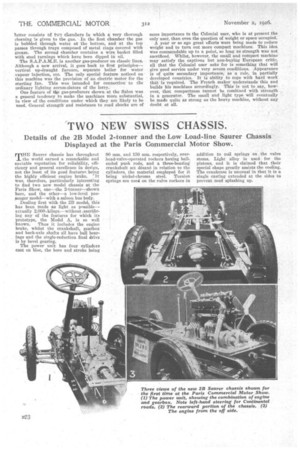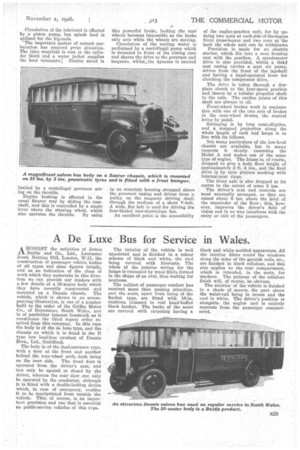'TWO NEW SWISS CHASSIS.
Page 54

Page 55

If you've noticed an error in this article please click here to report it so we can fix it.
Details of the 2B Model 2-tonner and the Low Load-line Saurer Chassis Displayed at the Paris Commercial Motor Show.
THE Saurer chassis has throughout the world earned a remarkable and enviable reputation for reliability, efficiency and general excellence in design, not the least of its good features being the highly efficient engine brake. 'It was, therefore, particularly interesting to find two new model chassis at the Paris Show, one—the 2-tonner—shown bare, and the other—a low-level pasBanger model—with a saloon bus body.
Dealing first with the 2B model, this has been made as light as possibleecturdly 2,000,kilogs.—without.sacrificing any of the features for which its prototype, the Model A, is so well known. Thus it includes the engine brake, whilst the crankshaft, gearbox and back-axle shafts all have ball bearings and the single-reduction final drive is by bevel gearing.
The power unit has four cylinders• cast on bloc, the bore and stroke being 00 mm. and 150 mm. respectively, overhead-valve-operated rockers having ballended push rods, and a three-bearing crankshaft set desaxe in relation to the cylinders, the material employed for it being nickel-chrome steel. Torsion springs are used on the valve rockers in
addition to coil springs on the valve stems. Light alloy is used for the pistons, and it is claimed that their special shape greatly assists the cooling. The crankcase is unusual in that it is a single casting extended at the sides to prevent mud splashing up. Circulation of the lubricant is effected by a piston pump, but splash feed is utilized for the big-ends.
The important matter of correct carburation has received great attention. The inlet manifold is cnst in the cylinder blcick and a water jacket supplies the heat eecessary.1, .Engine speed is
limited by a centrifugal governor acting on the throttle.
Engine braking is effected in the usual Saurer way by sliding the camshaft, and this is controlled by a single lever above the steering wheel, which also operates the throttle. By using this powerful brake, locking the rear wheels becomes impossible as the brake only acts while the wheels are moving.
Circulation of the cooling water is performed by a centrifugal pump which is mounted in front of the timing case and shares the drive to the governor and magneto, whilst:the dynamo,is carried
in an eccentric housing strapped above the governor casing and driven from a pulley mi. the magneto driving shaft through the medium of a short V-belt. A wide, flat belt is used for driving the four-bladed cast-aluminium fan.
An excellent point is the accessibility of the engine-gearbox unit, for by undoing two nuts at each side of the-engine front cross-bearer and two nuts at the back the whole unit can be withdrawn Provision is made for an electric starter, which fits into a neat housing cast with the gearbox. A speedometer drive is also provided, whilst a third cast casing carries a neat air pump, driven from the front of the layshaft and having a hand-operated lever for clutching the compressor drive.
The drive is taken through a dryplate clutch to the four-speed gearbox and thence by a tubular propeller shaft to the axle. The cardan joints of this shaft are always in oil.
Pront-wheel brakes work in conjunction with one of the two sets of brakes in the rear-wheel drums, the control being by pedal.
Springing is by long semi-elliptics, and a stamped projection along the whole length of each leaf keeps it in line with its fellows.
Not many particulars of the low-level chassis are available, but in many respects it closely resembles the Model A and makes use of the same type of engine. The frame is, of course, dropped to give a body floor height of approximately 2 ft. 4 iris., and the final drive is by spur pinions meshing with internal-gear rings.
The front axle is also dropped at its centre to the extent of some 8 ins.
The driver's seat and controls are most unusually arranged, as they are raised about 6 ins, above the level of the remainder of the floor; this, however, improves the driver's field of vision and in no way interferes with the entry or exit of the passengers.




























































































































